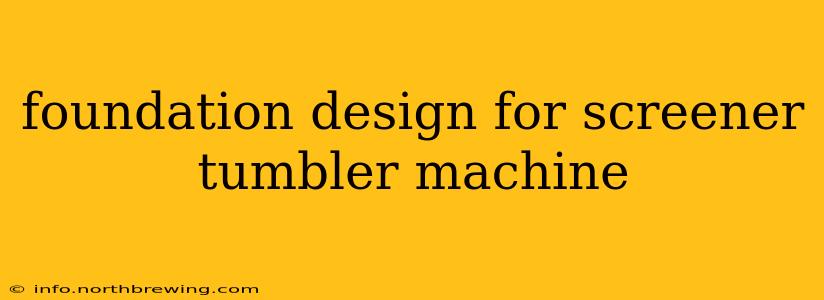Designing a robust and stable foundation for a screener tumbler machine is crucial for its smooth operation, longevity, and safety. A poorly designed foundation can lead to vibrations, premature wear and tear, and even equipment failure. This guide delves into the key considerations for designing a foundation that ensures optimal performance and minimizes potential problems.
What are the Critical Factors Affecting Foundation Design?
Several factors influence the design of a foundation for a screener tumbler machine. These include:
- Machine Weight and Dimensions: The foundation must be strong enough to support the machine's total weight, including the material being processed. Accurate weight and dimensional specifications are essential for accurate calculations.
- Operating Vibrations: Screener tumbler machines generate vibrations during operation. The foundation design must effectively dampen these vibrations to prevent them from transferring to the surrounding structure and causing damage or nuisance.
- Soil Conditions: The type of soil beneath the foundation significantly impacts its design. Considerations include bearing capacity, drainage, and potential for settlement or shifting. Soil testing is usually necessary to determine the appropriate foundation type and design parameters.
- Environmental Factors: Factors like temperature fluctuations, moisture content, and potential for freezing and thawing can affect the foundation's stability and longevity.
- Accessibility for Maintenance: The foundation design should allow easy access for regular maintenance and repairs of the screener tumbler machine.
What Types of Foundations are Suitable?
Several foundation types can support a screener tumbler machine, each with its advantages and disadvantages:
- Concrete Slab: This is a common and relatively simple option, particularly for smaller machines. A reinforced concrete slab provides a solid and level base. However, it may not be sufficient for larger, heavier machines or those generating significant vibrations.
- Concrete Block Foundation: Using concrete blocks to create a raised foundation offers good stability and allows for easier access for maintenance. This approach is suitable for moderate-sized machines.
- Steel Frame with Concrete Fill: This more robust design involves a steel frame that provides structural support, with the interior filled with concrete for added mass and stability. This is a good option for larger and heavier machines or those operating in challenging soil conditions.
How Do I Calculate the Foundation's Size and Reinforcement?
Accurate calculation of the foundation's size and reinforcement is crucial for its structural integrity. This typically involves:
- Determining the total weight of the machine and its contents.
- Considering the dynamic loads generated during operation (vibrations). This may require specialist engineering calculations.
- Analyzing soil conditions to determine the allowable bearing pressure. A geotechnical engineer can help with this.
- Selecting appropriate concrete mix design to achieve the required strength.
- Designing the reinforcement (steel bars) to withstand the stresses and vibrations.
What About Vibration Isolation?
Controlling vibrations is critical for a screener tumbler machine. Strategies include:
- Selecting a foundation type that provides inherent damping (e.g., a massive concrete base).
- Using vibration isolation mounts between the machine and the foundation. These mounts absorb vibrations and reduce their transmission to the surrounding structure.
- Designing the foundation with vibration-damping materials incorporated into the concrete mix.
How Do I Ensure Proper Drainage?
Proper drainage is essential to prevent water accumulation around the foundation, which can lead to settlement and damage. This can be achieved through:
- Grading the surrounding ground to direct water away from the foundation.
- Installing drainage pipes or French drains to collect and remove excess water.
- Using a waterproof membrane beneath the concrete slab.
What are Common Mistakes to Avoid?
Common mistakes in foundation design include:
- Underestimating the machine's weight and vibrations.
- Ignoring soil conditions.
- Insufficient reinforcement of the concrete.
- Neglecting proper drainage.
- Poorly constructed concrete work (cracks, voids).
By carefully considering these factors and employing appropriate design techniques, you can ensure a stable and durable foundation for your screener tumbler machine, ensuring optimal performance and a long service life. Consulting with structural and geotechnical engineers is highly recommended, especially for large or complex projects.
